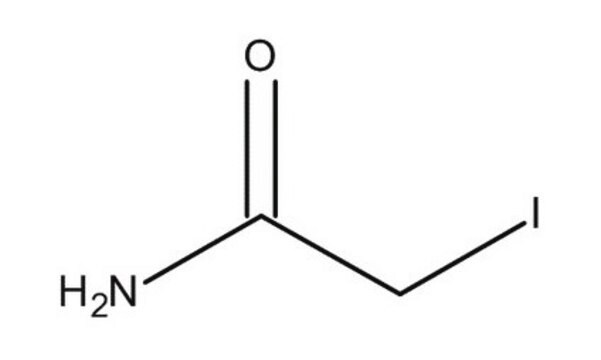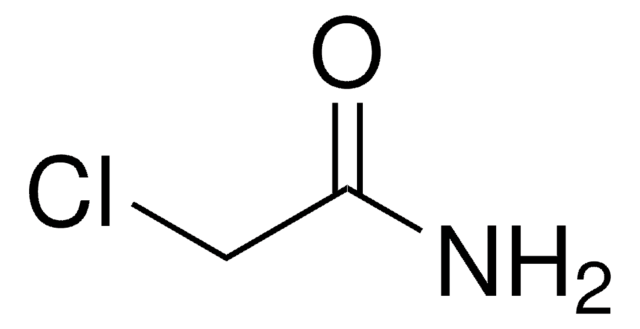All Photos(1)
About This Item
Linear Formula:
ICH2CONH2
CAS Number:
Molecular Weight:
184.96
Beilstein/REAXYS Number:
1739080
EC Number:
MDL number:
UNSPSC Code:
12352202
NACRES:
NA.21
Recommended Products
biological source
synthetic
Quality Level
assay
≥99% (NMR)
form
powder
mp
92-95 °C (lit.)
solubility
H2O: 0.5 M, clear, colorless
suitability
suitable for manufacturing use
storage temp.
2-8°C
SMILES string
NC(=O)CI
InChI
1S/C2H4INO/c3-1-2(4)5/h1H2,(H2,4,5)
InChI key
PGLTVOMIXTUURA-UHFFFAOYSA-N
Looking for similar products? Visit Product Comparison Guide
General description
Our SAFC® portfolio of high-quality raw materials for use in biopharmaceutical processing withstands strict quality control procedures plus the documentation and expertise to help our customers meet requirements as defined by the M-Clarity Program.
M-Clarity Program
Our comprehensive portfolio of upstream process chemicals not only provides biopharmaceutical manufacturers with high-quality raw materials for production of classical and novel therapies, but also helps them get to market faster and simplify regulatory challenges. Trust us to deliver supply chain transparency and reliable sourcing around the globe, streamlining your product qualification with best-in-class regulatory support and service.
M-Clarity Program
Our comprehensive portfolio of upstream process chemicals not only provides biopharmaceutical manufacturers with high-quality raw materials for production of classical and novel therapies, but also helps them get to market faster and simplify regulatory challenges. Trust us to deliver supply chain transparency and reliable sourcing around the globe, streamlining your product qualification with best-in-class regulatory support and service.
Biochem/physiol Actions
Iodoacetamide acts as an alkylating reagent for cysteine residues in peptide sequencing. It is an irreversible inhibitor of enzymes with cysteine at the active site. It reacts much more slowly with histidine residues, but that activity is responsible for inhibiting ribonuclease.
Legal Information
SAFC is a registered trademark of Merck KGaA, Darmstadt, Germany
signalword
Danger
hcodes
Hazard Classifications
Acute Tox. 3 Oral - Aquatic Chronic 4 - Resp. Sens. 1 - Skin Sens. 1
Storage Class
6.1C - Combustible acute toxic Cat.3 / toxic compounds or compounds which causing chronic effects
wgk_germany
WGK 3
flash_point_f
Not applicable
flash_point_c
Not applicable
Choose from one of the most recent versions:
Already Own This Product?
Find documentation for the products that you have recently purchased in the Document Library.
Customers Also Viewed
Mia Jüllig et al.
PloS one, 9(5), e96489-e96489 (2014-05-08)
Bypass of foregut secreted factors promoting insulin resistance is hypothesized to be one of the mechanisms by which resolution of type 2 diabetes (T2D) follows roux-en-y gastric bypass (GBP) surgery. To identify insulin resistance-associated proteins and metabolites which decrease more
Valentina R Minciacchi et al.
Oncotarget, 6(13), 11327-11341 (2015-04-11)
Large oncosomes (LO) are atypically large (1-10 µm diameter) cancer-derived extracellular vesicles (EVs), originating from the shedding of membrane blebs and associated with advanced disease. We report that 25% of the proteins, identified by a quantitative proteomics analysis, are differentially
Jeremy Rouillon et al.
Neuromuscular disorders : NMD, 24(7), 563-573 (2014-05-13)
Diagnosis of muscular dystrophies is currently based on invasive methods requiring muscle biopsies or blood tests. The aim of the present study was to identify urinary biomarkers as a diagnostic tool for muscular dystrophies. Here, the urinary proteomes of Duchenne
Elena B Lugli et al.
Arthritis research & therapy, 17, 9-9 (2015-01-21)
Smoking is a well-established risk factor for rheumatoid arthritis (RA), and it has been proposed that smoking-induced citrullination renders autoantigens immunogenic. To investigate this mechanism, we examined human lung tissue from 40 subjects with defined smoking status, with or without
Francesco Trepiccione et al.
Kidney international, 86(4), 757-767 (2014-05-03)
Almost half of patients receiving lithium salts have nephrogenic diabetes insipidus. Chronic lithium exposure induces AQP2 downregulation and changes in the cellular composition of the collecting duct. In order to understand these pathophysiological events, we determined the earliest lithium targets
Our team of scientists has experience in all areas of research including Life Science, Material Science, Chemical Synthesis, Chromatography, Analytical and many others.
Contact Technical Service










